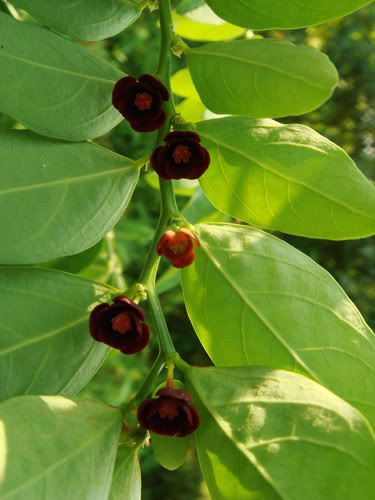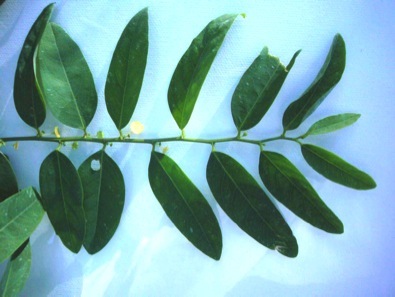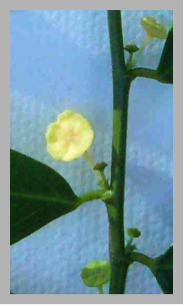Edible Katuk: Sauropus androgynus
Katuk grows reluctantly in my yard. It likes truly tropical climes and I am on the subtropical/temperate line. But it’s still a favorite nibble and a staple vegetable in many parts of the world.
Katuk has a tasty leaf with a pea-like or nutty flavor. It’s also half protein, an amazing amount for a vegetable. More so, the leaves can be quickly stripped from the stem by pulling it between your fingers. Tender tips, leaves, flowers, small fruits and seeds of the Katuk are eaten raw or cooked, from soup to salad.
Also known as the Sweetleaf Bush, Katuk is native to lowland rain forests and prefers a hot, humid climate. Hot and humid I’ve got, but not the lowland forest. I have not been able to get it above medium shrub stage here in central Florida, but from what I read it never gets much beyond a big shrub anyway. As mentioned I am exactly on the line between subtropical and temperate, which means an occasional freeze and one or two light frosts per winter. When a freeze threatens I take in clippings.
Katuk (ka-TOOK) will grow in shade or full sun, but it will not tolerate being dry. Under ideal conditions, it can grow up to a foot a week but it is never sturdy. Regular trimming assures optimal production of new tender shoots, prime food for Asian markets. One is supposed to keep it pruned to between 3-6 feet whereas mine has never exceeded four feet. The best way to propagate it is to take a cutting and put it in water, changing the water often. Another way is to take a stem and stick in the ground under some moist shade.
The leaves and the top four or five inches of a branch tip have a pleasant taste, similar to fresh garden peas, and slightly nutty. They are usually are eaten raw in salads, or steamed. You can add them to stir-fry, rice and egg dishes, soups or casseroles. The leaves retain their color and texture when cooking, which is fine for salads but you might want to chop them a little for soups or frying. They are often served in restaurants under the name “sayur manis.” The tiny flowers and fruit are also edible, though I have never noticed any fruit on my Katuk bushes.
Katuk is quite nutritious with the nutrient content is higher in more mature leaves. Though it is dwarfed by the Moringa trees in my yard, I eat the Katuk far more often than the Moringa just out of taste. Raw the Katuk has an after taste that sits well on the palate, the Moringa can be sharp and bitter, if not peppery. More so, the Moringa easily grows 12 feet a season, where as the Katuk just gets a manageable bushy. (My Moringa article is here.)
As to Katuk’s scientific name, Sauropus androgynus. (SAW row-puss an-DROG-ah-nus.) What it means is known, as both words are Latinized Greek. Why the plant is called what it is called is a little harder. Androgynus, in the plant world, means having flowers that are either male or female. Sauropus means “lizard-foot.” Why “lizard foot” is anyone’s guess. By the way: Change the ending of Sauropus to Saururus and you have Lizard Tail, a different plant species with medicinal qualities.
By now you should know Katuk is one of the most popular vegetable in the world, particularly in Borneo and my home in Florida. Now some information to keep the lawyers happy:
Every now and then some people get suckered and become human lab rats. This happened in Taiwan in the mid-1990’s involving Katuk. Although Katuk has been consumed for thousands of years without issue, and is consumed daily by millions without a problem, there is always someone around to do something excessive and stupid. The rest of us end up with a warning and worry.
Some vendors in Taiwan convinced people that an extract of raw Katuk was good for weight loss… yep, a fad diet. The vendors sold extract of ground Katuk leaves mixed with fruit juice. Fifty-four people, 50 females, four males, developed lung problems, most of which went away upon stopping the diet. Four middle-aged women, however, who drank 3.5 to 7 ounces (100g to 200g) a day of the extract for up to two months had to have lung transplants within a year and a half of consuming the extract. This is the human equivalent of over-dosing a lab rat to induce disease. More so, not only did these four take the extract they also ate a lot more raw Katuk while taking the extract. Only mother’s milk wouldn’t hurt you at that rate, and maybe even that would. Despite proven dangerous, this fad diet persisted and 9 cases were found in Japan in 2006 causing one death and one lung transplant.
The poisonings are believed related to papaverine in the plant, which makes blood vessels open up and is not an uncommon treatment for high blood pressure. There is about 580 mg of papaverine per 100g of raw Katuk leaf, or about the same as four prescriptions capsules of papaverine to 3 ounces of raw leaf. The theory is in high doses it permanently damaged the tiny blood vessels in the lung. Researchers have not been able to recreate the symptoms in lab rats which has led some to think the problem might have a genetic component.
A follow-up study of 278 people in Taiwan with non-fatal symptoms found the median consumption of Katuk was 5.3 ounces a day of raw leaf for 20 days. Their consumption was about seven times the average consumption of Katuk by symptom-free Malaysians, which is three to six ounces a week, not a day. It was, it seems, too much of a good thing done wrongly. A 2006 study on rats showed that in a controlled experiment Katuk did help rats lose weight and reduce their triglycerides. Clearly it needs more research.
So, what does all this mean, beside don’t eat Katuk if you are taking something to open your blood vessels or lower your blood pressure? Enjoy Katuk as an addition to salads, a lawn-side nibble, and cooked in various dishes like you find in thousands of restaurants. Just don’t consume a half a pound of it a day raw for weeks or months and/or while taking an extract as well. I have been tossing a dozen leaves in my weekly salads for more than five years. I ain’t concerned.
Katuk’s nutritional content is outstanding: 49% protein, 18% fiber, vitamins A, B & C, potassium 2.77% (more than bananas at 1.48%); calcium 2.77% (dried skim milk is less than half that at 1.3%); phosphorus .61% (dried soybeans are at .55%); magnesium .55%; and even enough iron to mention.
Incidentally, in beast and woman, Katuk stimulates milk production. And no doubt out there somewhere in the world a man will eat a bushel a day and start lactating then we’ll have that to worry about, too.
Green Deane’s “Itemized” Plant Profile
IDENTIFICATION: Bush, upright with multiple stems, three to six feet high; dark-green, oval-shaped leaves 5-6 cm long. Flat, round, yellow to red flowers, small 1-2cm across, form in the leaf axils. In tropical climates, a purple capsule forms with small, black seeds. May need two different trees to fruit.
TIME OF YEAR: Here in central Florida it loses its leaves for a couple of months in our light winters, but has leave available for the rest of the year, blossoms in summer and fall. It is pest free.
ENVIRONMENT: Understory tree, likes some shade or full sun, prefers hot humid climate, can’t tolerate frost or freezing.
METHOD OF PREPARATION: Leaves, tips, flowers and fruits edible raw or cooked, raw in moderation




